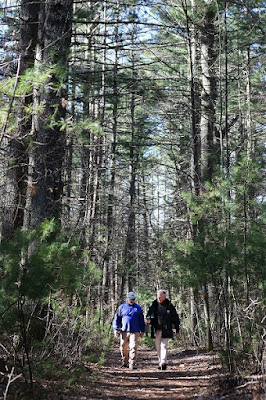In mid-April, pine warblers had
taken over the Audubon Society of Rhode Island’s Fisherville Brook Wildlife
Refuge in Exeter. Their high-pitched, insect-like buzzy songs could be heard
everywhere one turned, from the parking lot to the pond to the densest woodland.
But they weren’t the only birds making themselves
heard and seen during the early days of spring migration. A pair of
red-shouldered hawks called out to each other as they soared overhead and
performed their mating ritual in anticipation of nesting in the refuge in the
ensuing weeks. A pair of eastern phoebes had nearly completed construction of
their nest on a support beam of the informational kiosk. And red-breasted
nuthatches, pine siskins, black-capped chickadees and several other
forest-nesting species appeared to be making plans for the future.
 |
| A stroll through Fisherville Brook (Glenn Osmundson) |
Fisherville, a mosaic of five properties acquired
since 1988 that now totals 1,010-acres, is an ideal place to observe the
important role that forests play in providing habitat for a diversity of
wildlife. It’s also representative of the abundance of ecosystem services that
forests contribute to the region’s human population, from protecting the water
quality in local aquifers and sequestering carbon from the atmosphere to
cooling the environment, reducing soil erosion and providing a stress-free
place for rest, recreation and rejuvenation.
“Fisherville protects the headwaters of the Queen
River, one of the most biodiverse rivers in the state,” said Scott Ruhren,
Audubon’s senior conservation director. “And the reason it’s one of the most
biodiverse rivers in the state is because it runs through protected forests
almost all the way to the Pawcatuck River, including through our Eppley
Wildlife Refuge.”
Large undisturbed tracts of forest are especially
valuable in supporting wildlife and the services that people require.
“Humans have a history of fragmenting forests into
smaller patches, but small woodlots lose diversity, they get warmer more
quickly, they tend to get invaded by pests, and they’re less able to store and
filter water,” Ruhren said. “We take them for granted, but it’s vitally
important that we protect large, intact forest ecosystems.”
Audubon’s executive director Larry Taft agrees.
When asked what he likes most about Fisherville, he said, “its bigness.”
While size is indeed important when it comes to
forest conservation, what is equally important today in Rhode Island is that
the state acknowledge the vital role forests play in the region and establish a
process to protect essential forest habitats. That’s why Audubon worked with
partners to develop the Rhode Island Woodland Preservation and Stewardship Act
of 2019, a bill that was introduced to the General Assembly in April by Rep.
Arthur Handy and Sen. Bridget Valverde. When passed, the legislation will give
the Rhode Island Department of Environmental Management the authority to
promote the stewardship of forests and woodlands in partnership with cities,
towns and private landowners.
“Wetlands, farmland, coastal lands and soils are
all protected in the state, but not upland woods,” said Taft as he walked
through Fisherville. “Forests like this have no standing under the law in Rhode
Island. There is no grand plan or incentive for people to use or protect or appreciate
the environmental services they provide.”
Forested lands have been under increasing threat
in recent years. Over the past century, the primary threat to Rhode Island’s
wildlife and their habitats... Read the rest of this article in the Summer 2019 issue of Audubon Report.
No comments:
Post a Comment